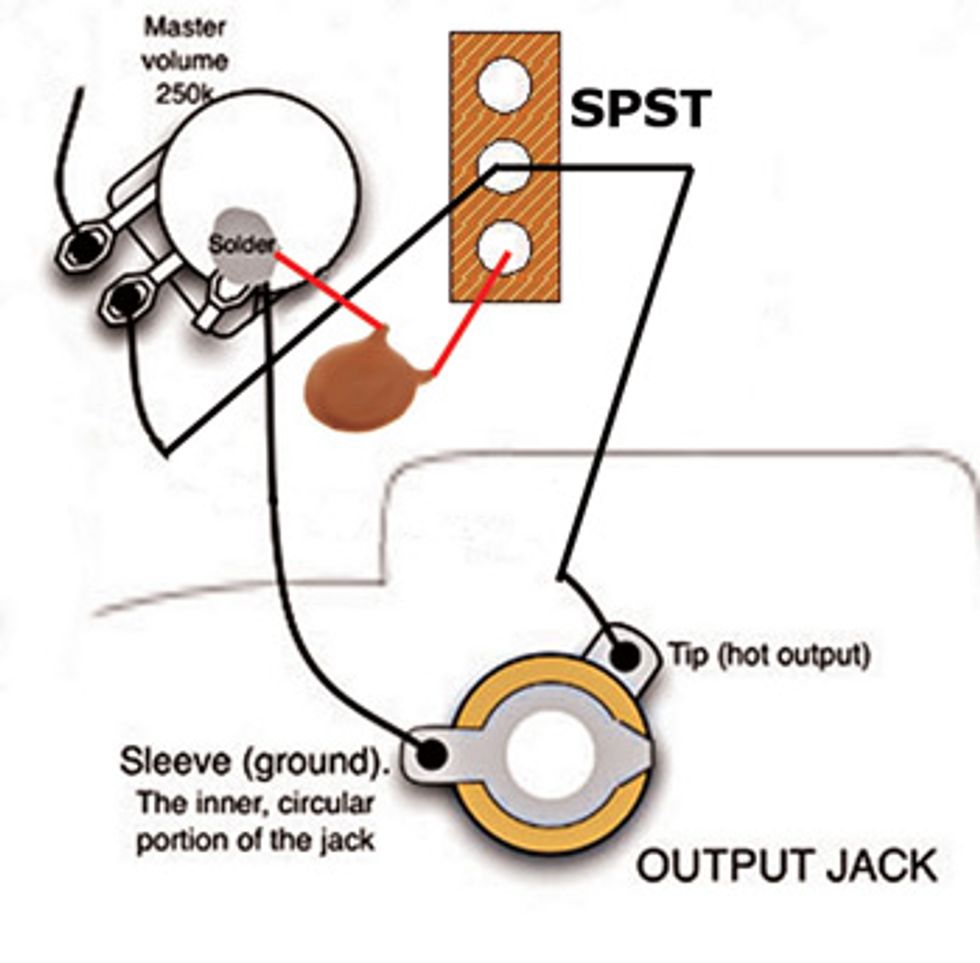Have you ever noticed, when looking at photos of ’60s guitar heroes like Eric Clapton and
Jimi Hendrix, the old-fashioned spiral cords
connecting their guitars and amps? At the
time, most guitarists used these cables not
for tonal reasons, but because they looked
cool and the choice of instrument cables
was very limited. From our modern point of
view, these cables were low quality with lousy
shielding, but back in the golden days of
electric guitar, they were it.

Wiring diagram courtesy of Seymour Duncan Pickups and used by permission. Seymour Duncan and the stylized S are registered trademarks of Seymour Duncan Pickups.
These cables had an immense influence on the tone of the day, as even short spiral cords took away a lot of top-end bite. The use of 30-foot spiral cords to connect guitars and amps result- ed in a "warmer" sound (i.e., less top end) than we are used to today. That translated into a slightly muffled clean sound, frequently leaving guitarists to crank the treble on their amps or plug in a treble booster to make up the difference. It also resulted in a monstrous overdriven sound, especially with vintage single-coil pick- ups. And isn’t that what we’re trying to achieve today when we play with distortion?
Such cables have been out of production for many years. Modern spiral cords are high-quality, low-capacitance designs that only mimic the appearance of the old cables for a retro look on stage. But it is a fact that these vintage cables are an important part of the sound we know and love from classic records. Realizing that Jimi Hendrix would sound different with a modern guitar cable, I thought it was time to figure out how to simulate these vintage cables, without unplugging our modern ones.
This seems very easy to do at first glance— simply add some capacitance with an additional capacitor. But proper placement of the capacitor is crucial for this mod. If the mod is switched off, we want it completely out of the circuit, so we can enjoy the transparent tone our modern guitar cables provide. But when the mod is engaged, we want a full simulation of that ’60s tone, warts and all.
So let’s start with some recommended cap values for simulating varying lengths of vintage coiled cable:
10-foot (3 meters): 1nF
15-foot (4.5 meters): 1.5nF
20-foot (6 meters): 2.2nF
30-foot (9 meters): 3.3nF
Ultra-long: 4.7nF
I chose standard values, so you should have no problem getting these caps from any local electronic store or online supplier. Keep in mind your cap selection can further influence the tone. Personally, I feel that the modern, cheap ceramic caps sound closest to the old guitar cables, but naturally you can also try silver mica caps, film and foil caps, or anything in between.
To perform this mod, you need one of the caps mentioned above and a SPST on/off switch (you can also use a push/pull or push/ push pot). As I mentioned earlier, it’s all about placement, so take a look at the diagram. If you want to be more flexible, you can use an on/off/on switch and choose between two caps—I recommend 1.5n and 4.7n for three completely different tones. And if you want to go wild, you can also use a rotary switch with several caps for an ultra-flexible guitar. And remember, if you use a film and foil cap, con- nect the outside foil end to ground (see last month’s column for details).
From a technical point of view, the added capacitance is shifting down the resonance frequency of the Strat pickups, so they sound fatter when using overdrive. This is exactly the reason why a lot of vintage-voiced distortion and fuzz boxes use an additional cap at the input section—the resulting overdrive tone is fat and warm. This mod works best with typical vintage Strat pickups or a typical vintage PAF. Modern high-output pickups don’t sound very good with this mod. If you want to make your Strat sound more Les Paulish, try a 4.7n for the additional cap. Your Strat will sound very muffled when playing clean, but ultra-fat and punchy when using overdrive! I wouldn’t recommend any values higher than 4.7n.
Keep in mind that only a small roll back of the guitar’s volume pot will cut a lot of highs right from the start. Additionally, if you use a treble bleed network that works perfectly with your modern cable, it will stop working with the vintage cable mod because it is now mismatched. But that’s the nature of the beast with this simple, yet effective mod. A lot of players have told me this mod is one of the most usable out there, so make sure to give it a try. Until next month, keep on modding!
Dirk Wacker
Dirk Wacker lives in Germany and has been addicted to all kinds of guitars since the age of 5. He is fascinated by anything related to old Fender guitars and amps. He plays country, rockabilly, surf, and Nashville styles in two bands, works regularly as a studio musician for a local studio, and writes for several guitar mags. He is also a hardcore DIY-er for guitars, amps, and stompboxes, and he runs an extensive webpage—singlecoil.com—on the subject.







![Rig Rundown: Russian Circles’ Mike Sullivan [2025]](https://www.premierguitar.com/media-library/youtube.jpg?id=62303631&width=1245&height=700&quality=70&coordinates=0%2C0%2C0%2C0)

















